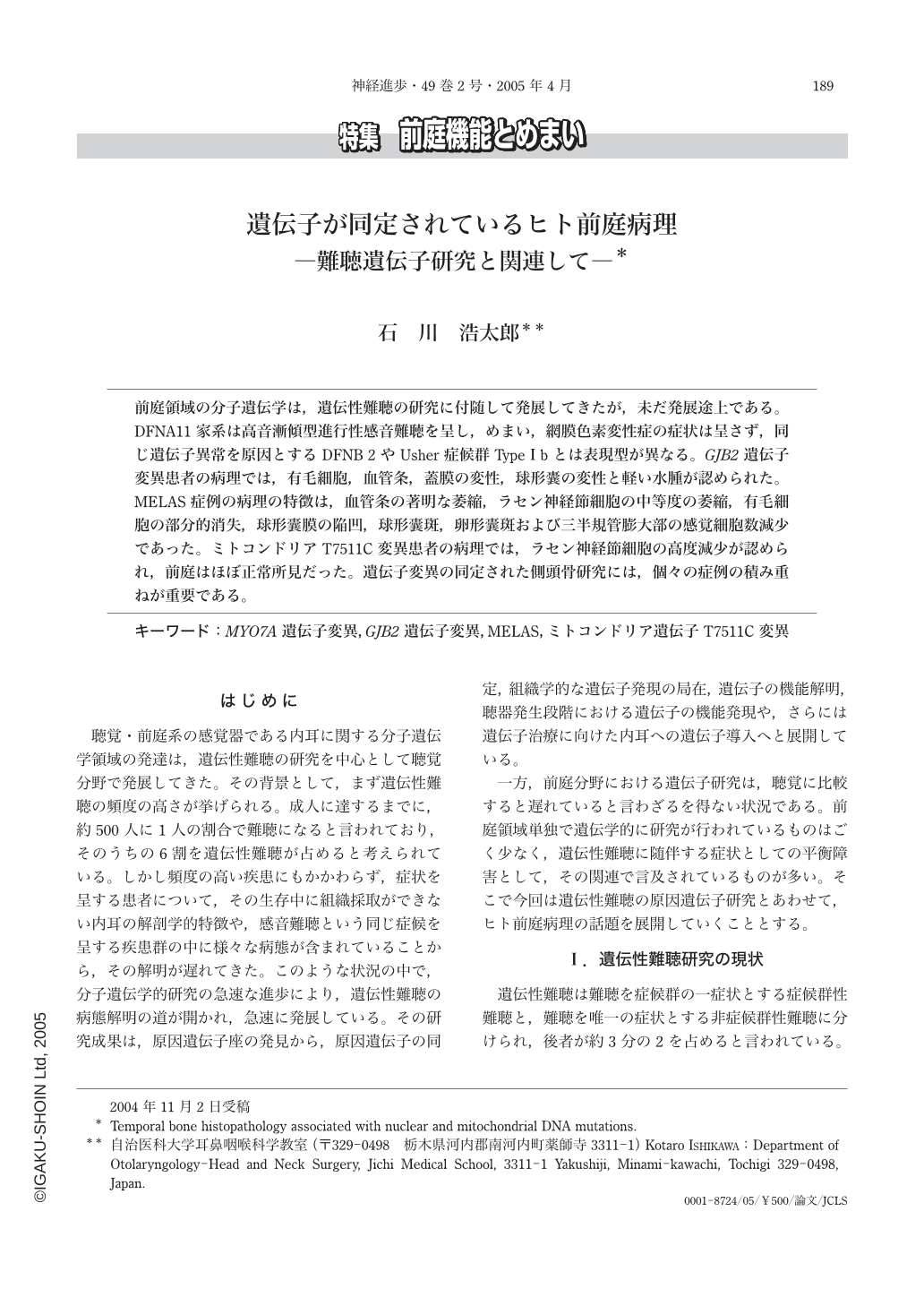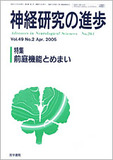Japanese
English
- 有料閲覧
- Abstract 文献概要
- 1ページ目 Look Inside
前庭領域の分子遺伝学は,遺伝性難聴の研究に付随して発展してきたが,未だ発展途上である。DFNA11家系は高音漸傾型進行性感音難聴を呈し,めまい,網膜色素変性症の症状は呈さず,同じ遺伝子異常を原因とするDFNB 2やUsher症候群TypeⅠbとは表現型が異なる。GJB2遺伝子変異患者の病理では,有毛細胞,血管条,蓋膜の変性,球形囊の変性と軽い水腫が認められた。MELAS症例の病理の特徴は,血管条の著明な萎縮,ラセン神経節細胞の中等度の萎縮,有毛細胞の部分的消失,球形囊膜の陥凹,球形囊斑,卵形囊斑および三半規管膨大部の感覚細胞数減少であった。ミトコンドリアT7511C変異患者の病理では,ラセン神経節細胞の高度減少が認められ,前庭はほぼ正常所見だった。遺伝子変異の同定された側頭骨研究には,個々の症例の積み重ねが重要である。
Revolutionary advances in molecular genetics have had great impact on the clinical study of hereditary hearing loss. In addition, the study of molecular genetics in vestibular organ have progressed with the study of hereditary hearing loss. Since 1991, many loci and genes for hereditary hearing loss have been reported, as listed on the Hereditary Hearing Loss Homepage.
DFNA 11 was mapped to a region of chromosome 11 in a Japanese family by Tamagawa et al. in 1996. The phenotype of DFNA11, caused by a mutation in the myosinⅦA gene, is post lingual nonsyndromic sensorineural hearing loss with gradual progression. Showing moderate hearing loss with asymptomatic vestibular dysfunction and no retinal degeneration, the DFNA 11 phenotype was milder than those of DFNB 2 and Usher syndrome caused by the myosinⅦA mutation. The temporal bone histopathology has never been studied.
DFNB1 was identified by Guilford et al. in 1994. Mutations in the gene GJB2, which encodes the gap junction protein Connexin 26, were shown to be responsible for deafness at this locus. The study of temporal bone histopathology of the GJB2 mutation was reported by Jun et al. in 2000. This report showed no neural degeneration, a good population of spiral ganglion cells, near-total degeneration of hair cells in the organ of Corti, a detached and rolled-up tectorial membrane, agenesis of the stria vascularis, and cochlea and vestibular hydrops.
Hearing loss often occurs as an additional symptom in a number of syndromic diseases caused by mitochondrial DNA mutations. It is common for mitochondrial mutations to give rise to different phenotypes in different families or patients. Many studies reported that the majority of cases of MELAS(mitochondrial encepharopathy, lactic acidosis and stroke-like episodes)are linked to the mitochondrial A3243G mutation. Takahashi et al. reported that temporal bone histopathological analysis of MELAS in 2003. Their patient suffered from sensorineural hearing loss, convulsion, stroke-like episodes, and vertigo. Serum pyruvate and lactate levels were both elevated. Ragged red fibers were observed in a muscle biopsy specimen. A clinical diagnosis of MELAS was made, and blood DNA testing revealed the mitochondrial A3243G mutation. Histopathological examination of MELAS revealed severe degeneration of the stria vascularis, spiral ganglion cells, and hair cells in the saccular macula. There was pathological collapse of the membranous wall of the saccule.
Sensorineural hearing loss is the most common feature of mitochondrial diseases, often occurring in the presence of other clinical abnormalities. We investigated histopathology of temporal bone of one subject suffering from nonsyndromic hearing loss with the mitochondrial T7511C mutation. The subject died at 60 years old of cerebral infarction. He noticed hearing loss at 5 years old, and suffered from progressive sensorineural hearing loss. As for other clinical disorders, he had diabetes mellitus, idiopathic diabetes insipidus, and intracerebral hemorrhage. Any other members in this family did not have these complications. His audiogram showed symmetrical and down-sloping shape. The most characteristic histopathological finding was severe loss of spiral ganglion cells in all turns of cochlea. The organ of Corti showed scattered losses of inner and outer hair cells in the basal turn. Partial atrophy of the stria vascularis was observed in all turns of cochlea. The saccules, the utriculus and lateral crista ampullaris showed normal findings.
There are few reports of human vestibular histopathology associated with nuclear and mitochondrial mutations. It is hoped that the number of study increases more and more in future.

Copyright © 2005, Igaku-Shoin Ltd. All rights reserved.


